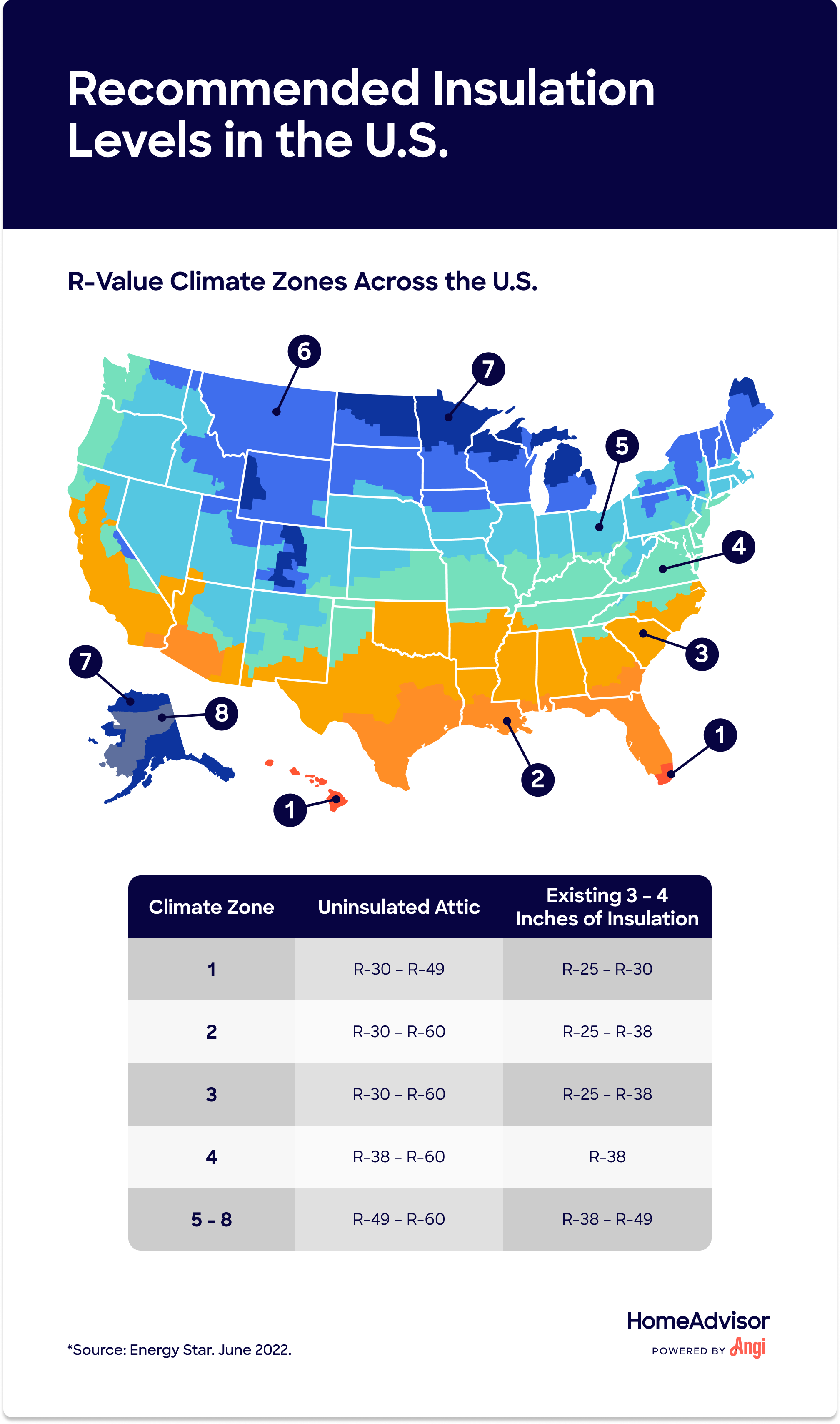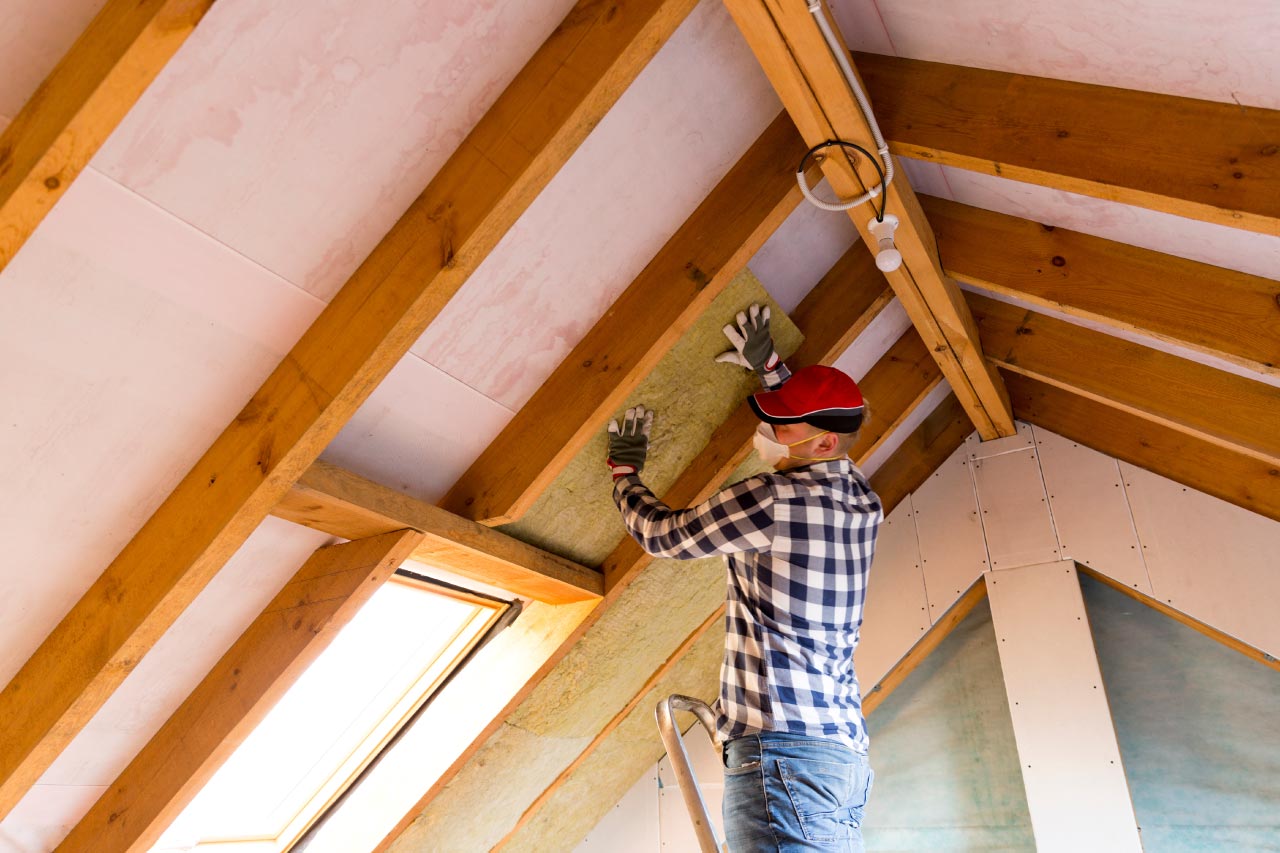How Much Does It Cost to Insulate an Attic?
Typical Range:
$1,500 - $3,500
Typical Range:
$1,500 - $3,500
Cost data is based on research by HomeAdvisor.
Updated April 15, 2024
Written by HomeAdvisor.Hiring a pro for attic insulation ensures correct installation, safe handling of materials, and potential asbestos removal.
The average cost of attic insulation ranges from $1 to $7 per square foot, depending on insulation type.
Factors impacting the cost of attic insulation include type of insulation, attic accessibility, local laws on asbestos, and labor costs.
Popular attic insulation materials include reflective insulation, blown-in, batt, spray foam, loose-fill, and structural insulated panels.
Reflective insulation is ideal for older attics, blown-in insulation is cost-effective, and structural insulated panels offer high energy efficiency.
Highlights were summarized from this existing cost guide text using automation technology and were thoroughly reviewed for accuracy by HomeAdvisor Editor Ryan Noonan.
The average cost for attic insulation, including materials and labor, is $2,500 and can range anywhere from $1,500 to $3,500. Installing attic insulation will help keep your home temperature more consistent, lower your energy bills, and can make your home more appealing to future buyers. This guide will help you understand the various kinds of insulation and several cost factors to consider.
| Average Cost | High Cost | Low Cost |
|---|---|---|
| $2,500 | $3,500 | $1,500 |
Attic insulation generally costs $1 to $7 per square foot. This can vary depending on how easily accessible your attic is and whether you’ll need to hire an electrician near you to check the wiring. The chart below provides a reasonable estimation based on your attic size.
| Attic Sq. Ft. | Average Price Range for Insulation |
|---|---|
| 500 | $500 – $3,500 |
| 700 | $700 – $4,900 |
| 1,000 | $1,000 – $7,000 |
| 1,500 | $1,500 – $10,500 |
The insulation type is one of the most significant variables determining the total project cost, and you can choose from several insulation materials. Reflective insulation is generally the least expensive option and can be ideal for older attics. In contrast, structural insulated panels are the most expensive and best for energy efficiency and new constructions.
| Insulation Type | Average Price Range per Sq. Ft. |
|---|---|
| Reflective | $0.50 – $1.50 |
| Blown-in | $1 – $4 |
| Batt | $2 – $4 |
| Spray foam | $2 – $5 |
| Loose-fill | $2 – $5 |
| Structural insulated panel | $4 – $7 |
Reflective insulation is a shiny layer of aluminum foil that can supplement other types of insulation, such as rigid foam, plastic film, or polyethylene bubbles. It costs about $0.50 to $1.50 per square foot. Most insulation types block heat escaping out of the home, but reflective options also block heat gain, which helps lower cooling costs in the summer.
Blown-in insulation costs around $1 to $4 per square foot and is one of the least expensive methods because the materials are inexpensive and installation takes less time. Pros use a blowing machine to fill the space with tiny chunks of cellulose, fiberglass, or mineral wool fiber.
Batt insulation costs around $2 to $4 per square foot and consists of long fiber rolls held together with a paper or reflective foil backing. Materials include fiberglass, cellulose, or even old blue jeans. While this style works well for expansive spaces, it doesn’t fill tight spaces well.
Spray foam insulation sticks to any surface, so your installer can apply it anywhere in the room. The cost for spray foam insulation is around $2 to $5 per square foot, and this type of insulation has a couple of options:
Open-cell: Less costly but doesn’t block moisture
Closed-cell: Denser and provides a better vapor barrier
Loose-fill attic insulation costs around $2 to $5 per square foot and is similar to blown-in insulation, except pros drop the material in place instead of blowing it. Loose-fill insulation often has a fluffy texture and is grayish-white in color.
However, if you currently have loose-fill insulation that resembles small gravel, it may contain asbestos, which can cause long-term health problems if you disturb it. Some states and municipalities require that only accredited asbestos mitigation pros near you remove the old insulation, so you’ll need to check your local laws.
Structural insulated panels are the most expensive because they’re extremely strong and energy-efficient. They cost around $4 to $7 per square foot and are layered pieces of rigid foam insulation attached to oriented strand board (OSB) or plywood. Since they’re much larger than other types—averaging 4-by-8 feet or bigger—they’re best for new construction.
R-value measures a material’s ability to resist heat traveling through it. The higher the R-value, the greater the insulation, or resistance to heat transfer. In general, insulation materials with higher R-values cost more than materials with lower R-values. For example, blown-in insulation—which averages $1 to $4 per square foot—has a low R-value, while structural insulated panels—which average $4 to $7 per square foot—have a higher R-value.
The recommended R-value for your attic depends on where you live and the climate in that location. Keep in mind that recommended R-values will also vary for different locations throughout your home. For example, your walls might only require R-30, while your attic requires R-60.
The labor cost to install attic insulation will fluctuate based on the location of your home, project complexity, and type of insulation. In general, expect to pay between $0.25 and $2.50 per square foot just for labor. But some insulation types, such as spray foam, require special training and certification to install and can run as much as $800, excluding materials.
In addition to the insulation material and your attic square footage, you may need to consider other cost factors when planning your budget.
If your attic is currently insulated and in good shape, a pro can simply add to it to bring the amount of insulation up to code. Batts, blown-in, or loose-fill insulation would all be good options in this case. But if your attic has little or no insulation or if the insulation is damaged and needs replacement, you’ll need to add significantly more.
Attic cleaning costs around $100 to $300 on top of the insulation price. This service includes a basic cleanup of the space to prepare for installation. If you want junk removal or organization, you’ll pay more.
The cost to replace attic insulation is around $2 to $8.50 per square foot, including about $1 to $2 per square foot for insulation removal costs. You may be able to keep what you have now if it’s dry and in good condition. Most homeowners add blown-in or spray foam insulation to the existing material.
Air sealing is a process that involves closing any gaps in the exterior walls, which helps to block moisture and avoid drafts. It costs approximately $250 to $750. Since it requires removing all the insulation to find air leaks, pros usually do it before installing new material. Air sealing is a great way to keep your insulation in good shape for years.
For most attic insulation projects, it’s best to hire an attic insulation company near you. Although adding some of these materials might not be too difficult, it’s best to have a pro to help you determine if you can keep what you have and what amount to add.
When it comes to removing insulation, some types—such as blown-in and loose-fill insulation—will require special training and equipment, such as an industrial hose. Also, older insulation materials like loose fill may contain dangerous asbestos, which you shouldn’t handle on your own.
Blown-in materials installed by a local blown-in insulation pro work well for most homes. This type can easily fill awkward spaces and nooks and crannies. But the best type of insulation depends on your specific attic and situation.
Yes, insulating your attic is worth it. By doing so, you can decrease your heating costs and save money on your monthly utility bills. Insulating your attic can also increase your home resale value by about as much as you paid.
In most cases, you can add more insulation on top of the material you already have in the attic. But if the insulation is wet or damaged, you’ll need to replace it.
Insulating an attic can take anywhere from five hours to two days. The project length depends on the insulation material you choose, with spray foam insulation taking about one to two days to install. Another factor is if you need to remove old insulation before adding in new material.
Yes, you can over-insulate an attic, although this isn’t as common as under-insulating your home. Too much insulation can lead to inadequate ventilation, blocked vents, and poor air circulation, resulting in mold or trapping in heat. To avoid these issues, contact your local insulation contractor about finding the right R-value for your home.

